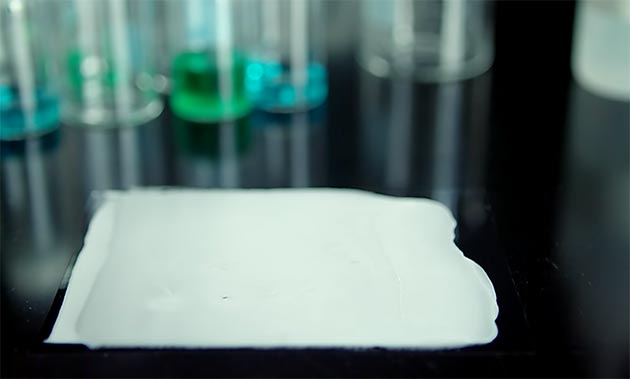Paint-like polymer could cool buildings
30th September 2018USA: Researchers at Columbia University, looking for ways to reduce the air conditioning load in buildings, have invented a paint-like polymer which can reflect sunlight and radiate heat.
Up to now, white paints have been the benchmark for passive daytime radiative cooling (PDRC) technologies. However, white paints usually have pigments that absorb UV light and they do not reflect longer solar wavelengths very well.
The team from Columbia Engineering, one of the top engineering schools in the US, is said to have invented a high-performance exterior PDRC polymer coating with nano-to-microscale air voids that acts as a spontaneous air cooler and can be fabricated, dyed, and applied like paint on rooftops and buildings, or anything that can be painted.

The polymer is said to have a porous foam-like structure. The air voids in the porous polymer reflect all wavelengths of sunlight, from UV to infrared. The polymer turns white and thus avoids solar heating, while its intrinsic emittance causes it to efficiently lose heat to the sky.
The process, it is said, can cool down structures to sub-ambient temperatures. The researchers found their polymer coating’s high solar reflectance (R > 96%) and high thermal emittance (Ɛ ~ 97%) kept it significantly cooler than its environment under widely different skies, eg by 6˚C in the warm, arid desert in Arizona and 3˚C in the foggy, tropical environment of Bangladesh.
“Nature offers many ways for heating and cooling, some of which are extremely well known and widely studied and others that are poorly known. Radiative cooling—by using the sky as a heat sink—belongs to the latter group, and its potential has been strangely overlooked by materials scientists until a few years ago,” commented Uppsala University Physics Professor Claes-Göran Granqvist, a pioneer in the field of radiative cooling, who was not involved with the study.
He added that the study “highlights the importance of radiative cooling and represents an important breakthrough by demonstrating that hierarchically porous polymer coatings, which can be prepared cheaply and conveniently, give excellent cooling even in full sunlight”.
The study has been published in Science magazine.









